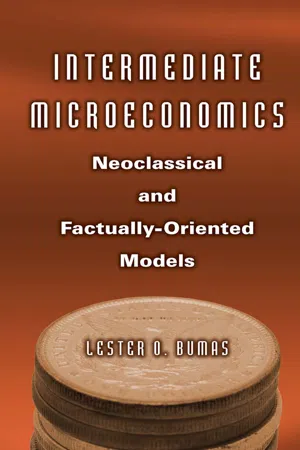Economics
Marginal Rate of Substitution
The Marginal Rate of Substitution (MRS) measures the rate at which a consumer is willing to trade one good for another while maintaining the same level of satisfaction. It represents the slope of the indifference curve and reflects the consumer's preferences for different combinations of goods. A higher MRS indicates a greater willingness to substitute one good for another.
Written by Perlego with AI-assistance
Related key terms
Related key terms
1 of 4
Related key terms
1 of 3
4 Key excerpts on "Marginal Rate of Substitution"
- eBook - ePub
- Andrew Barkley, Paul W. Barkley(Authors)
- 2016(Publication Date)
- Routledge(Publisher)
- Perfect substitutes are goods that a consumer is indifferent between. Perfect complements are goods that must be purchased together in a fixed ratio. Most goods are imperfect substitutes, meaning that they can be substituted with each other, but not perfectly.
- The Marginal Rate of Substitution (MRS) is the rate of exchange of one good for another that leaves utility unaffected and defines the slope of the indifference curve. The slope of the indifference curve is equal to the marginal valuation of the two goods.
- The budget constraint is the limit imposed on consumption by the size of the budget and the prices of the two goods.
- A consumer maximizes utility by locating at the tangency of the indifference curve and the budget line.
- The opportunity set includes all combinations of goods within the budget constraint of the consumer.
7.10 Glossary
Budget Constraint. A limit on consumption determined by the size of the budget and the prices of goods.Budget Line. A line indicating all possible combinations of two goods that can be purchased using the consumer’s entire budget.Cardinal Utility. Assigns specific, but hypothetical, numerical values to the level of satisfaction gained from the consumption of a good. The unit of measurement is the hypothetical util (see Ordinal Utility ).Indifference Curve. A line showing all possible combinations of two goods that provide the same level of utility (satisfaction).Law of Diminishing Marginal Utility. Marginal utility declines as more of a good or service is consumed during a given time period.Marginal Rate of Substitution [MRS]. The rate of exchange of one good for another that leaves utility unchanged. The slope of an indifference curve. MRS = ΔY2 /ΔY1 .Marginal Utility [MU]. - eBook - ePub
- Andrew Barkley, Paul W. Barkley(Authors)
- 2020(Publication Date)
- Routledge(Publisher)
- Perfect substitutes are goods that a consumer is indifferent between. Perfect complements are goods that must be purchased together in a fixed ratio. Most goods are imperfect substitutes, meaning that they can be substituted with each other, but not perfectly.
- The Marginal Rate of Substitution (MRS) is the rate of exchange of one good for another that leaves utility unaffected and defines the slope of the indifference curve. The slope of the indifference curve is equal to the marginal valuation of the two goods.
- The budget constraint is the limit imposed on consumption by the size of the budget and the prices of the two goods.
- A consumer maximizes utility by locating at the tangency of the indifference curve and the budget line.
- The opportunity set includes all combinations of goods within the budget constraint of the consumer.
7.10 Chapter 7 glossary
Budget Constraint —A limit on consumption determined by the size of the budget and the prices of goods.Budget Line —A line indicating all possible combinations of two goods that can be purchased using the consumer’s entire budget.Cardinal Utility —Assigns specific, but hypothetical, numerical values to the level of satisfaction gained from the consumption of a good. The unit of measurement is the hypothetical util (see Ordinal Utility ).Indifference Curve —A line showing all possible combinations of two goods that provide the same level of utility (satisfaction).Law of Diminishing Marginal Utility —Marginal utility declines as more of a good or service is consumed during a given time period.Marginal Rate of Substitution [MRS] —The rate of exchange of one good for another that leaves utility unchanged. The slope of an indifference curve: MRS = ΔY2 / ΔY1 - eBook - ePub
Microeconomics
A Global Text
- Judy Whitehead(Author)
- 2014(Publication Date)
- Routledge(Publisher)
The maximization of utility or satisfaction by the consumer, given prices and the consumer’s income (budget), is derived under the Ordinal theory with the use of several analytical tools. These include the indifference curves, the budget line and the mathematical technique of the Lagrangian multiplier method for constrained optimization.2.3.2.1 Indifference Curves
Indifference curves are consistent with the assumption of a ranking of consumer preferences (rather than measurement). Their shape implies the diminishing Marginal Rate of Substitution that replaces the disputed diminishing marginal utility in the Cardinal theory. The major features of these curves are as follows:- The curve is negatively sloped.
- The points along the curve represent the same level of utility from different combination of the two commodities.
- The further the curve is from the origin, the higher the level of utility (satisfaction).
- The curve is convex to the origin, implying diminishing Marginal Rate of Substitution of the commodities.
- The slope of indifference curve, measured by the tangent to a point on the curve, is called the Marginal Rate of Substitution and is expressed as:
It may be noted that the concept of Marginal Rate of Substitution (MRS ) is intended to replace the concept of marginal utilities. However, as will become clearer later, the Marginal Rate of Substitution is simply the ratio of the marginal utilities of commodities.Derivation of the indifference curve — finding the slope
Figure 2.3 illustrates the indifference curve and its properties. The curve is shown sloping downwards (i.e. negatively sloped) and with a reducing slope as it falls (i.e. it flattens out). The quantity of good y being given up (Δy ) to get an extra unit of good x (Δx ) is shown to fall as the consumer has more of good x .To find the slope of the indifference curve first consider the utility function:The indifference curve is the locus of points where utility (satisfaction) is constant, that is where there is zero difference in utility. Hence, it is necessary to find the total differential of the utility function and set it equal to zero. - eBook - ePub
Intermediate Microeconomics
Neoclassical and Factually-oriented Models
- Lester O. Bumas(Author)
- 2015(Publication Date)
- Routledge(Publisher)
Indifference curve analysis is ordinal in character. In this model the consumer is only required to decide whether or not one set of goods is preferred to another set. With a given budget, the set preferred to all others is that which maximizes satisfaction. No cardinal measures are required—making this an easier task for consumers to perform than that required by marginal utility analysis.The Indifference Curve
At the heart of the analysis is the indifference curve, an example of which appears in Figure 4.9 .The indifference curve is the locus of points involving combinations of the rates of consumption of two products or sets of products, X and Y , with all points on the curve yielding the same level of satisfaction.Since each point on the curve yields the same satisfaction as any other point, the individual consumer is indifferent to them and the various combinations of goods they represent. The indifference curve is generally postulated as being convex to the origin. The absolute magnitude of the slope of the indifference curve is declining. That slope is called the Marginal Rate of Substitution.The Marginal Rate of Substitution is the absolute value of the slope of the indifference curve at a point. It is the ratio of a change in the rate of consumption of Y , ΔY to a change in the consumption of X , ΔX .Figure 4.10. An Indifference MapThe reason for the declining absolute magnitude of the Marginal Rate of Substitution is not hard to find. Consider this by starting at a point on the curve where the rate of consumption of bread is relatively high and that of wine relatively low. At such a point, the consumer would be willing to trade off a substantial amount of bread for an additional bottle of wine a week. As she moves southeast on the indifference curve, less and less bread and more and more wine is consumed, and the magnitude of the trade-off changes. The consumer is increasingly satiated with wine but misses her bread and is, therefore, willing to give up decreasing amounts of bread to get a unitary increase in the consumption of wine. Thus, the absolute magnitude of the slope of the indifference function, the Marginal Rate of Substitution, declines as the rate of consumption of the product plotted on the horizontal axis increases.
Index pages curate the most relevant extracts from our library of academic textbooks. They’ve been created using an in-house natural language model (NLM), each adding context and meaning to key research topics.
Explore more topic indexes
Explore more topic indexes
1 of 6
Explore more topic indexes
1 of 4



